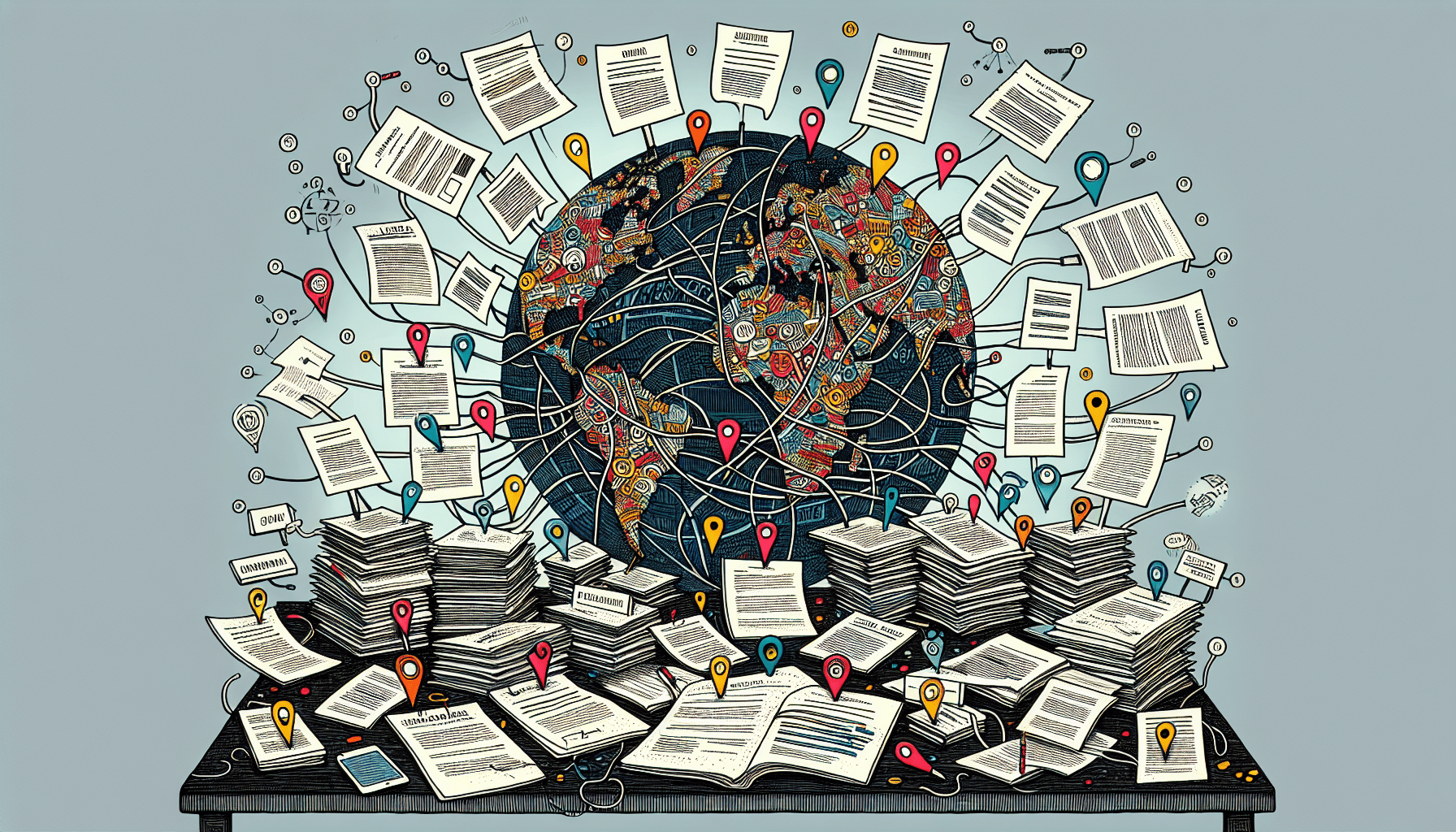As the business landscape evolves, ‘empowering the future of work’ becomes the cornerstone for success. This raises the question: How can your organization effectively leverage global talent and cutting-edge innovation for a robust work environment? Our article answers this, offering strategies for crafting a global workforce, nurturing remote and hybrid work cultures, and embracing technology—all imperative steps for thriving in the workspaces of tomorrow.
Key Takeaways
- Businesses are harnessing global talent to foster innovation and productivity, leveraging technology for international recruitment and creating inclusive, diverse working environments.
- Companies are cultivating remote-inclusive cultures and hybrid workplace strategies, emphasizing core values, connectivity, and the importance of recognizing remote achievements for enhanced employee engagement.
- Organizations venturing into international hiring must carefully navigate local employment laws, work permits, optimize global payroll operations, and use technology to empower remote workers while securing data.
Creating a Global Talent Pipeline

As the world becomes more interconnected, businesses are looking beyond their local markets to tap into the global talent pool. A global workforce, including international employees, brings new energy, ideas, and insights, making international hiring a strategic move that not only expands the international workforce but also increases productivity and creates a more inclusive work environment.
It’s like fishing in a vast ocean of skilled professionals rather than a small pond.
Identifying Skills in Demand
In the world of work, change is the only constant. As industries evolve, new skills rise in demand. Some of the in-demand skills globally include:
- Cloud computing expertise
- Artificial intelligence
- Translation
- Data analysis
Identifying these skills becomes a crucial part of the hiring process.
Building Brand Attraction Internationally
Attracting global talent goes beyond just posting job openings. It’s about building a compelling employer brand that resonates with international candidates. This involves understanding their career aspirations and personal goals, and showcasing how your company can help fulfill them. After all, who wouldn’t want to work for a company that supports their professional growth?
Leveraging Technology for International Recruitment
In today’s digital age, technology plays a pivotal role in international recruitment. Thanks to advancements in AI, businesses can now:
- Manage and filter the large volume of global applicants efficiently
- Utilize virtual reality tools to enhance the recruitment process
- Engage with international talent through mobile recruiting platforms
These technological advancements are revolutionizing the way companies approach international recruitment.
Imagine being able to experience your potential office culture remotely, or apply for a job using your mobile device – that’s the power of technology in international hiring.
Fostering a Remote-Inclusive Company Culture

While hiring internationally offers immense advantages, it also presents unique challenges. One such challenge is creating a remote-inclusive company culture. This involves fostering a supportive environment that starts right from the onboarding process. After all, a culture that values inclusion and supports a diverse remote workforce can be a game-changer in employee engagement.
Establishing Core Values for Remote Work
A successful remote work culture is built upon certain core values such as proactive communication, organization, and prioritizing the team. These values, when consistently demonstrated by leaders, ensure clarity and prevent mixed signals within remote teams. It’s like setting the ground rules for a game – everyone knows what to expect and how to play their part.
Encouraging Connectivity and Collaboration
In a remote work setup, connectivity and collaboration are the glue that holds the team together. This includes not just professional interactions but also personal conversations that help build chemistry among team members. After all, we are social beings, aren’t we? And who said water-cooler chats can’t happen virtually?
Recognizing and Celebrating Remote Achievements
Recognition can be a powerful motivator. This holds true even in a remote work setup. Acknowledging the contributions and achievements of remote team members can boost their morale and motivate them to perform even better. And the best part? It doesn’t always have to be a grand gesture. Even a simple ‘good job’ email can make a world of difference.
Designing a Hybrid Workplace Strategy

As the saying goes, “one size doesn’t fit all”. This holds true even for workplace strategies. Not everyone prefers to work remotely all the time, and not everyone wants to be in the office every day. Enter the hybrid working model – a flexible work model that balances office and remote work. It’s like having the best of both worlds!
Balancing Flexibility with Structure
Creating a successful hybrid workplace involves balancing flexibility with structure. This means:
- Setting clear, measurable, and achievable expectations for teams
- Allowing individuals the autonomy to achieve their goals
- Adopting an approach known as ‘Freedom with Framework’
Sounds like a win-win, doesn’t it?
Equipping Teams with the Right Tools
In a hybrid workplace, having the right tools is half the battle won. Platforms like HubSpot can support team members effectively, saving time and costs. After all, time is money, and any tool that helps save both is a boon in today’s fast-paced business environment.
Continuous Improvement through Employee Feedback
Feedback is the breakfast of champions, and this holds true even for hybrid workplaces. Gathering and incorporating employee feedback can help refine and enhance the benefits provided to employees within a hybrid work model. After all, who better to tell you what’s working and what’s not than the people who are actually using it?
Navigating Legal Considerations in International Hiring

International hiring, while beneficial, comes with its share of legal considerations. From adhering to local employment laws to correctly classifying employees versus contractors, there’s a lot to navigate when hiring employees. It’s like playing a game of chess – each move needs to be calculated to avoid any potential pitfalls.
Understanding Local Employment Laws
Understanding local employment laws is crucial when hiring internationally. It’s much like traveling to a foreign country – just like you need to understand and respect local customs and traditions, you also need to understand and adhere to local employment laws.
Mitigating Misclassification Risks
When looking to hire employees internationally, it’s crucial to correctly classify employees versus contractors, including domestic employees. Misclassifying employees can lead to legal penalties such as fines and employee back pay requirements. It’s like fitting a square peg in a round hole – it just doesn’t work.
Handling Visa and Work Permit Requirements
When hiring foreign workers internationally, handling visa and work permit requirements is a crucial step. After all, you wouldn’t want to face legal issues or penalties due to non-compliance, would you?
Optimizing Global Payroll and Benefits

Managing payroll and benefits for a global workforce can be quite a challenge. But with the right approach, it can become a strategic asset that not only ensures compliance but also enhances employee satisfaction.
Streamlining Global Payroll Operations
Streamlining global payroll operations can enhance accuracy, reduce error risks, and ensure compliance with local tax laws. With the right tools and systems in place, you can turn this complex task into a smooth and efficient process.
Customizing Benefits for Diverse Workforce
Customizing benefits for a diverse workforce can significantly increase employee satisfaction and engagement. After all, everyone has different needs and preferences, and a one-size-fits-all approach may not always work.
Providing Support for Personal Lives
Supporting employees’ personal lives, including their mental health, is just as important as supporting their professional growth. Offering flexible scheduling, remote work options, and employee assistance programs can go a long way in accommodating the diverse needs and preferences of a global workforce, ultimately leading to a better work life balance.
Leveraging Technology to Empower Remote Workers
Technology plays a pivotal role in empowering remote employees. In fact, 85 percent of companies have accelerated the digitization of their businesses. Whether it’s communication and collaboration platforms, project management tools, or security measures, technology can significantly enhance the effectiveness and productivity of remote workers.
Communication and Collaboration Platforms
In a remote work setup, communication and collaboration platforms are a lifeline. They enable team members to stay connected and work together seamlessly, regardless of their geographical location.
Project Management and Productivity Tools
Project management and productivity tools are the gears that keep the remote work machine running smoothly. They help manage tasks, track goals, and streamline workflows, thereby enhancing team productivity.
Security Measures for Protecting Data and IP
In the digital world, data security is paramount. Implementing robust security measures is crucial to protect sensitive company data and intellectual property.
After all, prevention is better than cure, isn’t it?
Scaling Up: Transitioning from Local to Global Operations
Scaling up from local to global operations is like taking a giant leap – it’s a significant move that can open up vast opportunities. However, it requires careful planning and execution to ensure success.
Strategic Planning for Global Expansion
Strategic planning is the roadmap for global expansion. It involves adapting to different business practices and customs, and understanding diverse cultures, legal systems, political environments, and economic conditions. A well-crafted business strategy is essential for success in this complex landscape.
Building a Local Presence in Foreign Markets
Establishing a local presence in international markets is like planting a seed in foreign soil. It requires understanding the local market, adapting to the local customs, and nurturing the local connections to help the seed grow into a flourishing plant.
Nurturing Leadership Across Borders
In a global business landscape, leadership transcends borders. Global leaders need to navigate cultural differences and tackle the complexities of international business. After all, a smooth sea never made a skilled sailor, did it?
Summary
In conclusion, the future of work is global. From creating a global talent pipeline and fostering a remote-inclusive company culture to designing a hybrid workplace strategy and navigating the legal considerations in international hiring, every step is a stride towards a more inclusive, diverse, and productive global workforce. So, are you ready to embrace the future of work?
Frequently Asked Questions
What is empowering in the workplace?
Empowerment in the workplace means enabling employees to take ownership of their work, contribute to decision-making, and make independent decisions. It involves fostering a culture where employees feel supported, confident, and able to take action on their own, as opposed to being micromanaged.
What are the three 3 main objectives of empowerment?
The main objectives of empowerment include enhancing individual and organizational effectiveness, fostering a positive work environment, and achieving long-term success. Empowerment aims to bring these benefits to the workplace.
What does the phrase the future of work mean?
The future of work refers to how various factors such as technology, demographics, and the nature of work itself will shape the way work is done in the future. It involves understanding potential shifts and preparing workforces and workplaces for these changes.
How do you adapt to the future of work?
To adapt to the future of work, it’s crucial to focus on digital literacy, customer relationship management, data-based decision making, innovative thinking, a growth mindset, and relationship management. Additionally, embracing a growth mindset, promoting learning opportunities, embracing technology, cultivating resilience, and maintaining a positive working environment are key strategies for successfully adapting to change in the workplace.
What are the benefits of a global talent pipeline?
A global talent pipeline brings new energy, ideas, and insights, expanding the talent pool, increasing productivity, and creating a more inclusive work environment. It can be a strategic move for international hiring.
About InTech Ideas
If you’re looking to elevate your tech strategy and drive business growth, InTech Ideas is here to help. We offer a comprehensive suite of services, including Software Development Teams, Product Development Fast Track, and Product Leadership & Advisory. Whether you need to scale your development team, fast-track your product, or bring in expert leadership, we provide tailored, people-first solutions that align with your company’s goals. Learn more about how we can support your journey by exploring our services or contacting us today to discuss your specific needs.

